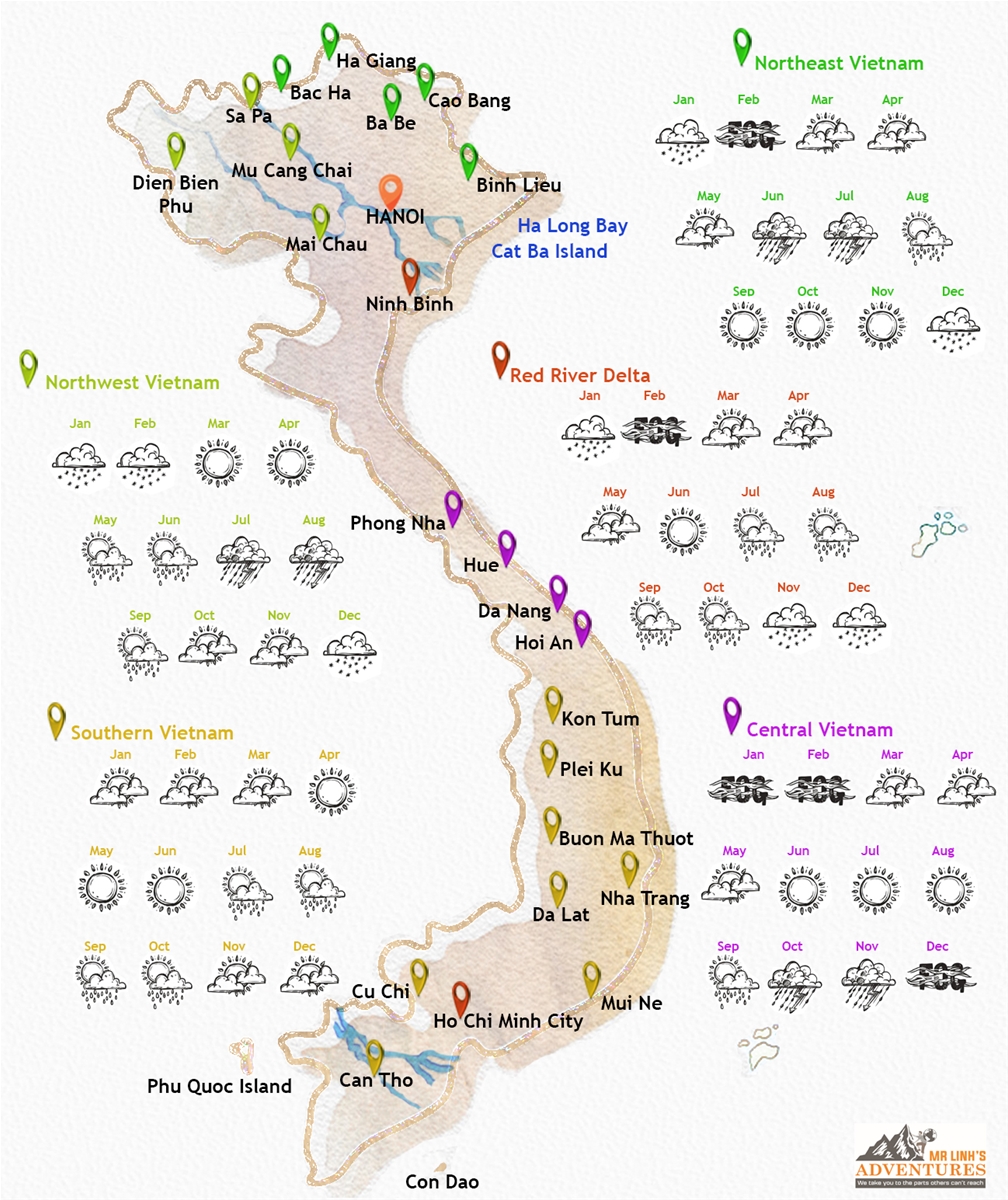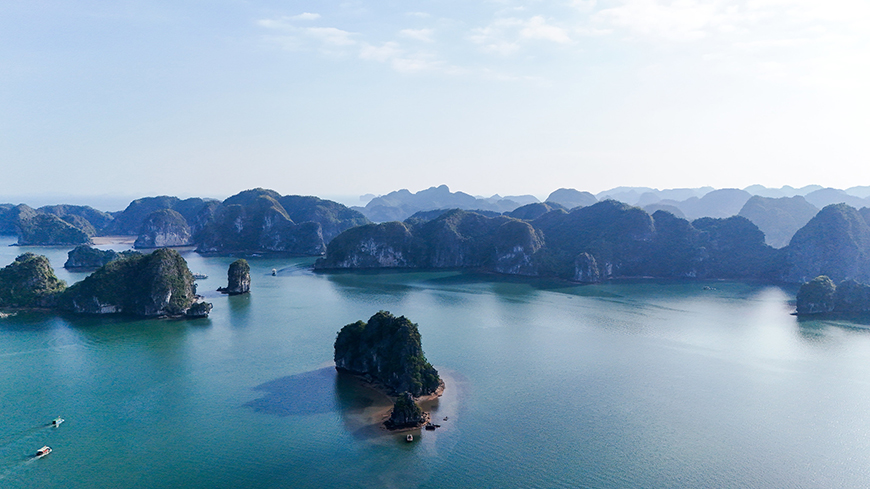Vietnam, a Southeast Asian country stretching over 1,600 km, has diverse climates depending on the regions. To fully enjoy your trip, it is essential to choose the right departure period.
Northern Vietnam - Contrasting seasons
Northern Vietnam, home to gems such as Hanoi, Ha Long Bay, Ninh Binh, Sapa, and Ha Giang, is characterized by its four distinct seasons. Spring (February to May) offers a pleasant mildness, ideal for exploring the region under light rains. Summer (June to August) is hot and humid, with occasional torrential rains, but it reveals the striking beauty of terraced rice fields, especially in Sapa or Mu Cang Chai. Autumn (September to November) is often considered the ideal season, with a cool and dry climate, perfect for outdoor activities. Winter (December to January) brings cooler, even cold temperatures in the mountains, accompanied by northeast monsoon winds.
Weather in Northern Vietnam: Seasonal Guide
✓ Best time: Between March and April and between September and November
✓ Climate: Four distinct seasons
✓ Winter (December-February): Cool and dry, 15-20°C
✓ Summer (May-August): Hot and humid, 30-35°C, typhoon risk
✓ To avoid: July-August (intense heat, heavy rains)
Typhoon risks in Northern Vietnam
✓ Risk period: July to October
✓ Most affected areas: Northeast coast, Ha Long Bay
✓ Average frequency: 2-3 typhoons per year
✓ Impact:
♦ Frequent closure of Ha Long Bay
♦ Disruptions to maritime and air transport
♦ Risks of flooding in Hanoi
✓ Maximum intensity: August-September

Choose the right time to visit Vietnam - Illustration : Mr Linh's Adventures
Central Vietnam - A transitional climate
Central Vietnam, marked by the Hai Van Pass dividing the region into two distinct climatic zones, offers a variety of weather conditions. North of the pass, from Phong Nha-Ke Bang to Hue, the climate is similar to the north, with four distinct seasons. In the south, destinations like Hoi An, Da Nang, Quy Nhon, and Nha Trang enjoy a tropical climate, warm and pleasant throughout the year. The ideal period to visit this region extends from December to September, offering generally favorable conditions for outdoor activities and cultural visits. However, caution is advised in October and November, months often marked by storms, heavy rains, and flood risks.
Weather in Central Vietnam: Seasonal Guide
✓ Best time: Between February and late May
✓ Climate: Dry season from February to July
✓ Rainy season: September to January
✓ Typhoon risk: October to November
✓ Temperatures: 20-35°C depending on the season
Typhoon risks in Central Vietnam
✓ Risk period: September to November
✓ Most exposed areas: Da Nang, Hue, Hoi An, Nha Trang
✓ Average frequency: 4-5 typhoons per year
✓ Impact:
♦ Frequent floods in Hoi An
♦ Risks of landslides
♦ Possible closure of tourist sites
✓ Maximum intensity: October
Southern Vietnam - Tropical weather
Southern Vietnam, including Ho Chi Minh City, the Mekong Delta, and beach destinations like Phan Thiet, Phu Quoc, and Con Dao, enjoys a tropical climate with two distinct seasons. The dry season, from November to April, is ideal for outdoor activities, beaches, and island excursions, with high temperatures but without the rains of the wet season. The rainy season, from May to October, is characterized by brief but intense showers, especially in the late afternoon. Although frequent, these rains generally do not hinder most activities and leave plenty of time to explore the region.
Weather in Southern Vietnam: Seasonal Guide
✓ Best time: December to April
✓ Climate: Two main seasons
✓ Dry season: December to April, pleasant temperatures
✓ Rainy season: May to November, short but intense showers
✓ Temperatures: 25-35°C all year round
Typhoon risks in Southern Vietnam
✓ Only the northern and central regions of the country are subject to storms

Magical Lan Ha Bay - Photo : Mr Linh's Adventures
Recommended periods for 2025
Vietnam can be visited pleasantly all year round. If cold and fog envelop one region, the sun and a clear sky always illuminate another. This climatic diversity, due to the country's geographical complexity, allows travelers to fully enjoy each region by choosing the ideal period to discover it. However, the following recommendations can be given:
Overall best period: February-March 2025
♦ Dry and sunny climate throughout the country
♦ Moderate temperatures
♦ Attractive prices outside school holidays
Intermediate period: November-December 2025
♦ End of rains in the south
♦ Pleasant temperatures in the north
♦ Risk of precipitation in the central region
Periods to avoid
♦ July-August 2025: Intense heat, significant rains
♦ Tet (Lunar New Year): January 29, 2025
• High prices
• Many sites closed
• Overcrowded transportation

When totravel to Vietnam ? Illustration : Mr Linh's Adventures
Practical tips
To make the most of your trip, good planning is essential. Start by booking your flights 4 to 6 months in advance to get the best fares. Avoid Western school holiday periods and opt for mid-week flights, often cheaper.
In terms of budget, it is important to note that the high season, from December to March, leads to price increases, sometimes up to 30% higher than in the low season, from May to September.
Finally, prepare your equipment according to the season. During the dry season, light clothes and good sun protection will suffice. If you travel during the rainy season, bring a raincoat and suitable shoes. And if you go to the north in winter, don't forget to pack warm clothes.
Travel according to your desires!
For an optimal trip to Vietnam in 2025, prioritize the months of February-March or November-December. These periods offer an ideal balance between favorable weather, reasonable prices, and moderate tourist influx. Adapt your itinerary according to the regions visited and expect variable weather, especially if you traverse the country from north to south. And most importantly, the best time to discover Vietnam is the one you choose!